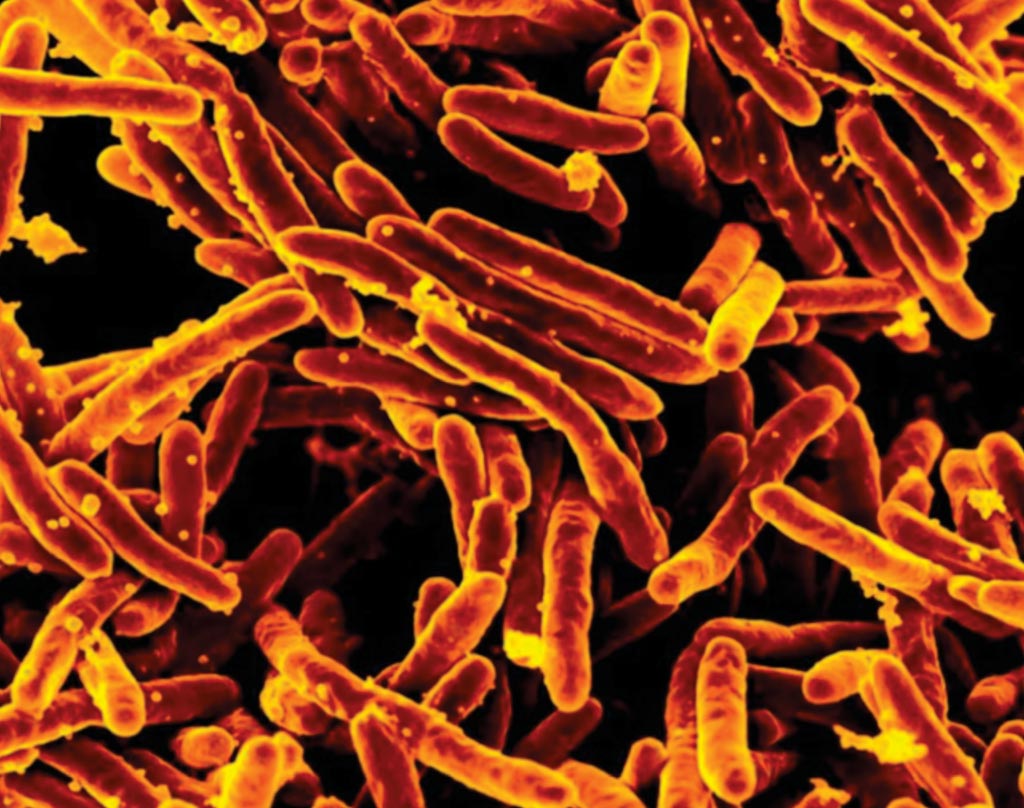Glutaraldehyde Test Evaluated for Rapid Tuberculosis Diagnosis
By LabMedica International staff writers
Posted on 16 Nov 2017
Tuberculosis (TB) remains one of the leading causes of morbidity and mortality worldwide and the primary method for controlling TB is the rapid and accurate identification of infected individuals.Posted on 16 Nov 2017
Smear examination and culture of Mycobacterium tuberculosis bacilli have remained the gold standard, but the sensitivity of the direct smear examination of sputum, however, is low, while culture is time-consuming, labo¬rious and not always available. Immune response exploitation represents one of the main methods used for early TB diagnosis.

Image: A digitally colorized scanning electron microscopic (SEM) image depicts a large group of orange-colored, rod-shaped Mycobacterium tuberculosis bacteria, which cause tuberculosis (TB) in human beings (Photo courtesy of US National Institute of Allergy and Infectious Diseases).
Microbiologists at the University Hospital Farhat Hached (Sousse, Tunisia) determined the diagnostic value of a glutaraldehyde test (GT) in pulmonary tuberculosis (PTB) and extra-pulmonary tuberculosis (EPTB) and to assess its performance compared with light-emitting diode fluorescence microscopy (LED-FM). This study included 272 specimens, 176 suspected PTB specimens and 96 suspected EPTB specimens. Of the 272 patients, 98 patients had TB infection confirmed by culture (64 PTB cases and 34 EPTB cases), and 174 patients had no TB infection. The gold standard technique (culture) was used as reference to verify the GT’s performance.
Sputum, extra-respiratory and blood samples for the GT were preferably collected on the same day. All specimens were subjected to smear examination, and each specimen was inoculated into Lowenstein-Jensen (LJ) and Coletsos culture media for up to eight weeks. Positive growth was confirmed by Ziehl-Neelsen staining, and mycobacterial isolates were identified using conventional biochemical techniques. The GT kit, ANDA-TB GA test case finding was used and a gelification time less than 10 minutes denotes a possible TB infection.
The team reported that the GT showed a high sensitivity (96.9%) and specificity (82.1%) for PTB with a good positive predictive value (PPV = 75.6%) and negative predictive value (NPV = 97.9%). For EPTB, the GT showed a sensitivity of 91.2% and a specificity of 77.4%, with PPV = 68.9% and NPV = 94.1%. LED-FM had lower sensitivities for PTB (65.6%) and EPTB (42.1%) and an excellent specificity of 100%, with PPV = 100% and NPV = 100%.
The authors concluded that the GT is rapid, easy, simple and cost-effective and does not require qualified personnel with a specific background or sophisticated equipment like molecular biology or mycobacterium-specific genotyping techniques. These qualities make the GT attractive for use in low- and high-income countries in addition to other conventional methods, particularly culture, which continues to be the gold standard. The study was published in the November 2017 issue of the journal Memórias do Instituto Oswaldo Cruz.
Related Links:
University Hospital Farhat Hached














